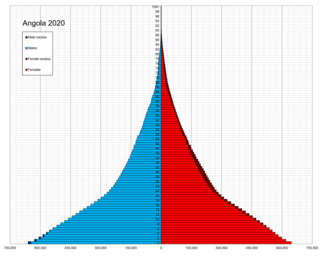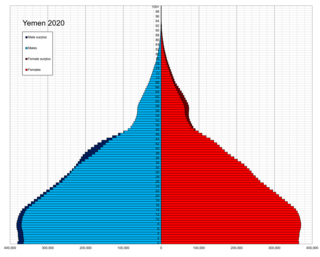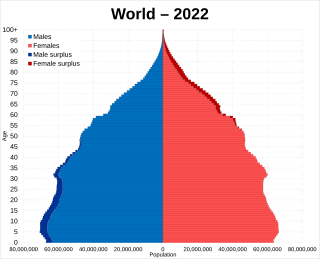Demographic statistics
| Average population [1] | Live births | Deaths | Natural change | Crude birth rate (per 1000) | Crude death rate (per 1000) | Natural change (per 1000) | |
|---|---|---|---|---|---|---|---|
| 1992 | 802 | ||||||
| 1993 | 760 | ||||||
| 1994 | 831 | ||||||
| 1995 | 830 | ||||||
| 1996 | 788 | ||||||
| 1997 | 713 | ||||||
| 1998 | 681 | ||||||
| 1999 | 733 | ||||||
| 2000 | 760 | ||||||
| 2001 | 748 | ||||||
| 2002 | 771 | ||||||
| 2003 | 842 | ||||||
| 2004 | 825 | ||||||
| 2005 | 894 | ||||||
| 2006 | 880 | ||||||
| 2007 | 927 | ||||||
| 2008 | 970 | ||||||
| 2009 | 1,008 | ||||||
| 2010 | 961 | ||||||
| 2011 | 1,028 | ||||||
| 2012 | 979 | ||||||
| 2013 | 992 | ||||||
| 2014 | 974 | ||||||
| 2015 | 1,067 | ||||||
| 2016 | 37,550 | 943 | 503 | 440 | 25.1 | 13.4 | 11.7 |
| 2017 | 38,350 | 950 | 494 | 456 | 24.8 | 12.9 | 11.9 |
| 2018 | 38,300 | 980 | 522 | 458 | 25.6 | 13.6 | 12.0 |
| 2019 | 38,150 | 939 | 528 | 411 | 24.6 | 13.8 | 10.8 |
| 2020 | 38,350 | 912 | 534 | 378 | 23.8 | 13.9 | 9.9 |
| 2021 | 39,100 | 978 | 607 | 371 | 25.0 | 15.5 | 9.5 |
| 2022 | 39,050 | 855 | 528 | 327 | 21.9 | 13.5 | 8.4 |
Structure of the population
| Age Group | Male | Female | Total | % |
|---|---|---|---|---|
| Total | 15 076 | 15 914 | 31 109 | 100 |
| 0–4 | 577 | 557 | 1 134 | 3.65 |
| 5–9 | 706 | 724 | 1 430 | 4.60 |
| 10–14 | 727 | 674 | 1 401 | 4.50 |
| 15–19 | 724 | 674 | 1 398 | 4.49 |
| 20–24 | 647 | 601 | 1 248 | 4.01 |
| 25–29 | 638 | 667 | 1 305 | 4.19 |
| 30–34 | 751 | 766 | 1 514 | 4.87 |
| 35–39 | 1 003 | 1 119 | 2 122 | 6.82 |
| 40–44 | 1 163 | 1 179 | 2 342 | 7.53 |
| 45–49 | 1 194 | 1 165 | 2 359 | 7.58 |
| 50–54 | 1 128 | 1 090 | 2 218 | 7.13 |
| 55–59 | 1 120 | 1 097 | 2 217 | 7.13 |
| 60–64 | 1 134 | 1 203 | 2 337 | 7.51 |
| 65-69 | 945 | 1 015 | 1 960 | 6.30 |
| 70-74 | 801 | 847 | 1 648 | 5.30 |
| 75+ | 1 530 | 2 228 | 3 758 | 12.08 |
| Age group | Male | Female | Total | Percent |
| 0–14 | 2 010 | 1 955 | 3 965 | 12.75 |
| 15–64 | 9 502 | 9 561 | 19 063 | 61.28 |
| 65+ | 3 276 | 4 090 | 7 366 | 23.68 |
| unknown | 288 | 308 | 715 | 2.30 |
| Age Group | Male | Female | Total | % |
|---|---|---|---|---|
| Total | 18 240 | 19 068 | 37 308 | 100 |
| 0–4 | 785 | 786 | 1 571 | 4.21 |
| 5–9 | 699 | 682 | 1 381 | 3.70 |
| 10–14 | 719 | 687 | 1 406 | 3.77 |
| 15–19 | 834 | 781 | 1 615 | 4.33 |
| 20–24 | 768 | 718 | 1 486 | 3.98 |
| 25–29 | 761 | 704 | 1 465 | 3.93 |
| 30–34 | 771 | 756 | 1 526 | 4.09 |
| 35–39 | 752 | 883 | 1 635 | 4.38 |
| 40–44 | 811 | 918 | 1 730 | 4.64 |
| 45–49 | 1 030 | 1 095 | 2 125 | 5.70 |
| 50–54 | 1 245 | 1 268 | 2 513 | 6.74 |
| 55–59 | 1 383 | 1 392 | 2 775 | 7.44 |
| 60–64 | 1 247 | 1 176 | 2 423 | 6.49 |
| 65-69 | 1 241 | 1 203 | 2 445 | 6.55 |
| 70-74 | 1 126 | 1 158 | 2 284 | 6.12 |
| 75-79 | 1 119 | 1 111 | 2 230 | 5.98 |
| 80-84 | 957 | 1 086 | 2 043 | 5.48 |
| 85-89 | 760 | 909 | 1 668 | 4.47 |
| 90-94 | 551 | 713 | 1 264 | 3.39 |
| 95-99 | 368 | 523 | 891 | 2.39 |
| 100+ | 314 | 518 | 832 | 2.23 |
| Age group | Male | Female | Total | Percent |
| 0–14 | 2 203 | 2 155 | 4 358 | 11.68 |
| 15–64 | 9 601 | 9 692 | 19 293 | 51.71 |
| 65+ | 6 436 | 7 221 | 13 657 | 36.61 |
| Year | Pop. | ±% p.a. |
|---|---|---|
| 1960 | 22,452 | — |
| 1970 | 23,484 | +0.45% |
| 1980 | 26,745 | +1.31% |
| 1990 | 29,972 | +1.15% |
| 2000 | 32,020 | +0.66% |
| 2008 | 35,352 | +1.25% |
| 2016 | 37,308 | +0.68% |
| 2018 | 38,300 | +1.32% |
| Source: IMSEE [3] [4] | ||
The following demographic statistics are from the CIA World Factbook , unless otherwise indicated.
This article was imported from the CIA's World Factbook . |
Age structure:
0-14 years: 12.3% (male 1,930/ female 1,841)
15-64 years: 60.8% (male 9,317/ female 9,249)
65 years and over: 26.9% (male 3,640/ female 4,562) (2012 estimate) 36% (2022 World Population Data Sheet estimate)
Population growth rate:−0.066% (2012 estimate)
Birth rate: 6.85 births/1,000 population (2012 estimate)
Death rate: 8.52 deaths/1,000 population (2007 estimate)
Net migration rate: 1.02 migrants/1,000 population (2007 estimate)
Sex ratio:
at birth: 1.04 male(s)/female
under 15 years: 1.05 male(s)/female
15-64 years: 1 male(s)/female
65 years and over: 0.81 male(s)/female
total population: 0.95 male(s)/female (2012 estimate)
Infant mortality rate: 1.8 deaths/1,000 live births (2012 estimate)
Life expectancy at birth (2023 estimate) [5] [6] :
total: 89.6 years (highest in the world)
male: 85.8 years (highest in the world)
female: 93.6 years (highest in the world)
Total fertility rate: 1.52 children born/woman in 2018
Nationality:
noun: Monegasque(s) or Monacan(s)
adjective: Monegasque or Monacan
Ethnic groups: French 47%, Monegasque 16%, Italian 16%, other 21%
Religions: Roman Catholic 90%, other 10%
Languages: French (official), English, Italian, Monegasque
Literacy:
definition: NA
total population: 99%
male: 99%
female: 99% (2003 estimate)

















